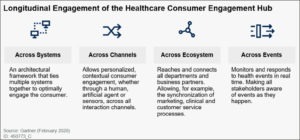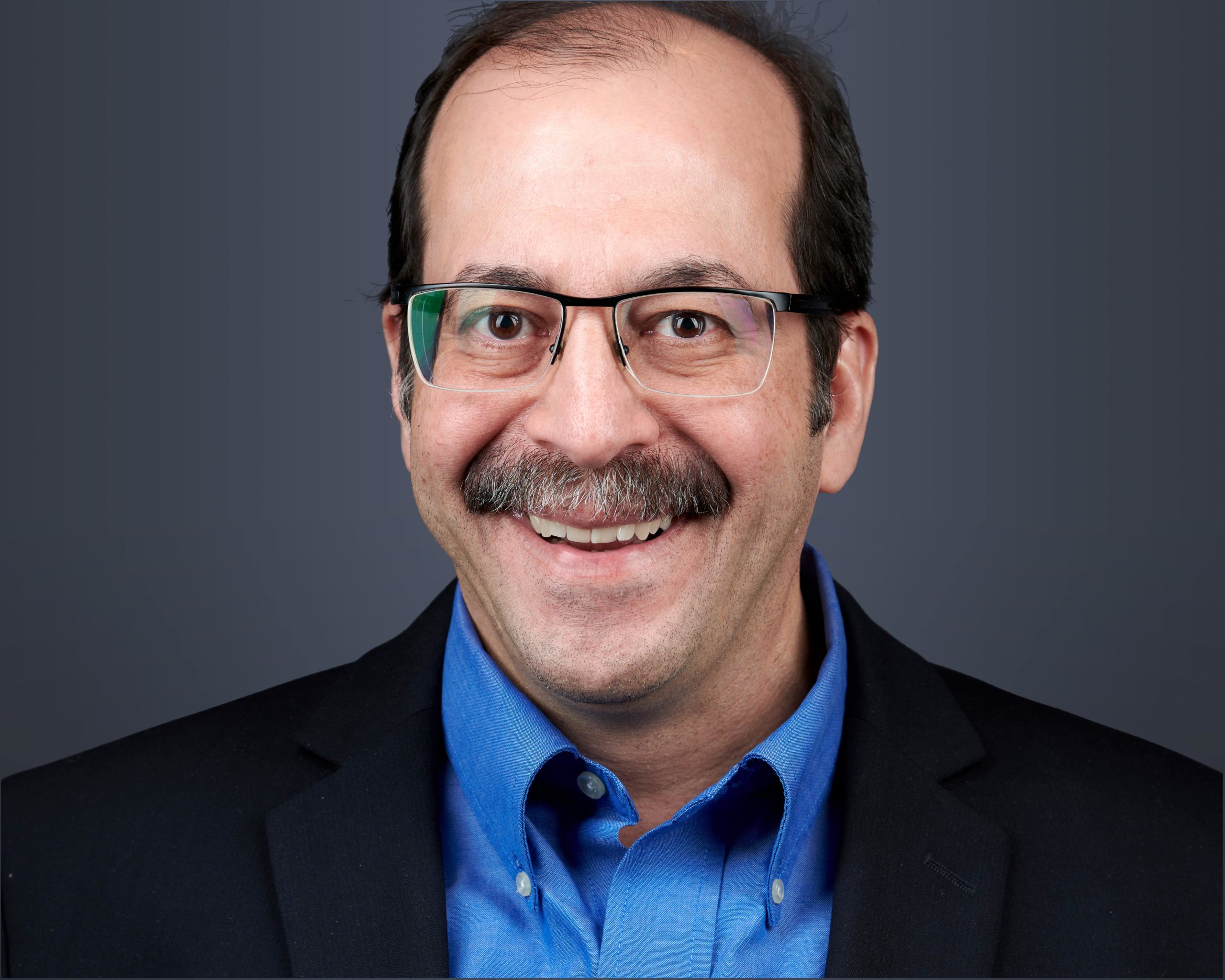The rise of healthcare consumerism is well documented, as detailed in a previous blog in this space that examines how consumers, in possession of an ever-increasing amount of health data, expect to be in control of a holistic, personalized healthcare journey.
To meet this expectation, a 2020 Gartner report (subscription) explores why healthcare CIOs from payer, provider and life sciences companies need to adopt a healthcare consumer engagement generations model that solves for the challenges of engaging with empowered healthcare consumers in a digital-first environment.
In short, the report breaks down why consumer engagement is a top-level initiative, and how a three-tiered generations model strategy advances an organization’s readiness to “act as one” in relationships with consumers across channels and business functions, and then finally across an entire healthcare ecosystem.
Consumer-Driven Changes
Before going into more detail on the consumer engagement generations model as outlined by Gartner, a Redpoint study in conjunction with Dynata highlights why consumer engagement is such a high-level initiative. In the report, more than half of the 1,000 consumers surveyed said that they do not receive a holistic healthcare experience, with 71 percent reporting poor experiences that include impersonal visits, long wait times, confusing processes and difficulty scheduling appointments. Furthermore, 54 percent said that neither providers nor insurers have the contextual information needed to personalize a healthcare experience – such as data from wearables and other consumer-driven products.
Armed with more personal data, consumers pressure healthcare organizations to help them act on that data in a way that matches a seamless experience to which they’re now accustomed.
The consumerism of healthcare changes how healthcare organizations have traditionally invested in technology for consumer engagement. In the past, consumer engagement was viewed as more of a means of an end, a pathway toward siloed processes such as acquisition, retention or improving Medicare Advantage ratings. Now, engagement is more in line with the overall end-to-end healthcare experience a consumer receives. The changing mindset does not diminish the importance of retention or acquisition, rather it considers all activities holistically; siloed data and siloed processes create friction for the end consumer, making it more difficult for a healthcare organization to personalize an experience with the goal of driving better outcomes, reducing costs and improving consumer satisfaction.
Consumer Engagement in Three Generations
Gartner outlines its generational approach as a guideline for how healthcare organizations can invest in and use technology to aid in a new approach toward consumer engagement. Generation 1 is all about preparation; healthcare organizations that adopt a new consumer-centric approach should build a business use case, determining the two or three most important consumer journeys for the organization and outlining a vision for what an improved journey might look like. The essential starting point, the report says, is the perspective of the consumer, with a typical journey consisting of a longitudinal set of experiences.
Experiences are bucketed into four categories: managing illness, accessing healthcare, managing wellness and caretaking. A focus on a specific consumer journey might be how to design an experience for a consumer who is adapting to a new chronic diagnosis (managing illness), or caring for an aging parent (caretaking). Identifying and mapping how those key consumer journeys might improve – what is the optimal course of action? – will shed light on what is needed from a technology standpoint to move into Generation 2 and Generation 3.
According to the Gartner report, most healthcare organizations are currently in Generation 1 – using consumer data to optimize one or a few consumer journeys that in most cases entail one busines until or process. These are typically single channel, static journeys with very little to no visibility into the consumer’s entire healthcare profile, or the consumer’s overall interactions.
A Consumer-Centric Approach: Act as One
The defining characteristic of Generation 2 and Generation 3 is that first the entire organization – all business units and channels – and then the entire healthcare ecosystem “act as one,” respectively, on behalf of the healthcare consumer. If, for example, a healthcare provider focused on a consumer adapting to a new chronic diagnosis as its Generation 1 initiative, it might move from assigning a home healthcare aid (involving a single business unit) to coordinating the patient’s care across the enterprise, with all departments accessing the same data to create a more seamless experience. Scheduling, procurement, outreach, administrative all acting as one on behalf of the patient.
In Generation 3, the holistic experience would also include the patient’s insurance company, the admitting hospital, a dialysis company or other third-party vendors – any stakeholder with an interest or investment in the patient’s healthcare. In Generation 3, the understanding is that consumers have access to and control of their health data from across the entire healthcare ecosystem. A consumer’s next-generation personal health record is independent of a specific healthcare organization or stakeholder. Rather, it ingests data from all permissioned sources and enables sharing with providers, insurers, caregivers, devices such as wearables, etc. There are no data, process, department or channel siloes that cloud a single view of the healthcare consumer – siloes that are largely responsible for the disjointed experiences that consumers cite in the Redpoint study, and others, as common frustrations with the healthcare system.
The Healthcare Consumer Engagement Hub
Gartner recommends a healthcare consumer engagement hub (HCEH) as the underlying technology to support longitudinal consumer engagement and underpin the generations model. (See Graphic 1). The HCEH moves healthcare organizations through each generation by tying multiple systems together to allow for a consumer engagement approach across channels, the ecosystem and events. The technology is the key to treating a consumer journey not as an episodic series of experiences, but rather understanding it as interactions that together compromise a lifelong health journey.

Gartner: Longitudinal Engagement of the Healthcare Consumer Engagement Hub
That understanding, supported by technology, allows for more personalized, contextual engagements with consumers across all channels. The “act as one” generational approach enables the new engagement approach by eliminating the barriers that have traditionally viewed sales and marketing, clinical encounters, administrative services and care management as distinct entities with different objectives. Without a comprehensive view of the healthcare consumer, it was not possible to focus on or deliver a personalized experience.
Consumer Engagement in Practice: Moving the Needle
Though it takes care not to make recommendations or mention technology vendors, the generational approach Gartner describes, as well as the technology capabilities that support a personalized healthcare experience, align with the Redpoint strategy and capabilities for helping healthcare organizations evolve their consumer engagement methodology.
The Redpoint rg1 platform is a consumer digital experience hub employed by healthcare organizations to accomplish many of the objectives laid out in the generational model. One healthcare sales, marketing and engagement organization partnered with Redpoint to power its multi-channel marketing campaigns, scale across different business models and improve member communications. Using rg1 to achieve a comprehensive view of the healthcare consumer, the company supported several hundred multi-channel marketing programs, resulting in a 60 percent reduction in onboarding costs and 25 percent reduction in marketing operation costs. Another Redpoint customer, a healthcare organization that provides an end-to-end operating system across payers and providers, uses rg1 as a digital experience for several end clients. The organization uses rg1 to achieve a single view of the healthcare consumer with an underlying goal of helping its clients transition to a value-based care (VBC) payment model that depends largely on providing a seamless, personalized healthcare experience to improve health outcomes.
One of its clients identified closing care gaps as a customer journey experience of focus. Care gaps had built up when the pandemic hit due to reduced hours or closing of facilities and operating at limited capacity. To achieve financial bonuses based on a value-based care payment model, the provider needed to close roughly 18,000 care gaps in 90 days.
With rg1 powering personalized communications and matching the right doctor with the right patient, the provider hit its goal. Specifically, it leveraged survey data from a partner provider and discovered that one healthplan’s members preferred female doctors over male doctors by a 60 percent margin. Before this realization, one marketing campaign aiming to schedule appointments to reduce care gaps reached out to every member using images of male doctors in the content. However, with insights from the survey data, marketing switched out the images of male doctors for members who expressed a preference for female doctors – resulting in a 15x increase in conversions.
Start the Transition Today
Healthcare organizations are increasingly embracing patient experience as a key metric because of its proven results in improving outcomes, reducing costs and improving the patient or consumer experience. Driven by consumers having more control over their health data, and their view of a healthcare journey as a lifelong connection of joined experiences rather than a series of disjointed episodes, healthcare organizations face pressure to respond in kind, delivering a holistic experience that matches consumer expectations.
By adopting a generational approach that will eventually “act as one” on behalf of the consumer, and supported by the right technology, healthcare organizations will be well on their way to refining a consumer engagement strategy that puts the healthcare consumer first and achieves desired business results and health outcomes.
Related Content
To Be More Effective Closing Care Gaps, the Healthcare Industry Needs a Single View of the Consumer
To Stanch Revenue Loss, Healthcare Providers Need to Embrace a Digital Mindset
A Dynamic Healthcare Journey Deserves a Coordinated, Personalized Approach
Be in-the-know with all the latest customer engagement, data management, and Redpoint Global news by following us on LinkedIn, Twitter, and Facebook.
